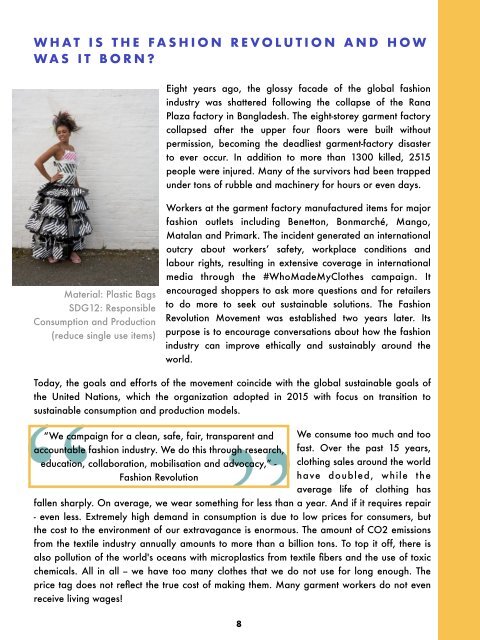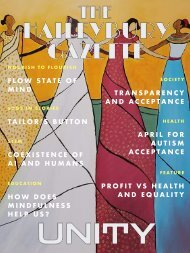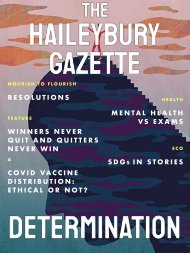Haileybury Gazette | Hope | Issue 9
You also want an ePaper? Increase the reach of your titles
YUMPU automatically turns print PDFs into web optimized ePapers that Google loves.
WHAT IS THE FASHION REVOLUTION AND HOW<br />
WAS IT BORN?<br />
Eight years ago, the glossy facade of the global fashion<br />
industry was shattered following the collapse of the Rana<br />
Plaza factory in Bangladesh. The eight-storey garment factory<br />
collapsed after the upper four floors were built without<br />
permission, becoming the deadliest garment-factory disaster<br />
to ever occur. In addition to more than 1300 killed, 2515<br />
people were injured. Many of the survivors had been trapped<br />
under tons of rubble and machinery for hours or even days.<br />
Material: Plastic Bags<br />
SDG12: Responsible<br />
Consumption and Production<br />
(reduce single use items)<br />
Workers at the garment factory manufactured items for major<br />
fashion outlets including Benetton, Bonmarché, Mango,<br />
Matalan and Primark. The incident generated an international<br />
outcry about workers’ safety, workplace conditions and<br />
labour rights, resulting in extensive coverage in international<br />
media through the #WhoMadeMyClothes campaign. It<br />
encouraged shoppers to ask more questions and for retailers<br />
to do more to seek out sustainable solutions. The Fashion<br />
Revolution Movement was established two years later. Its<br />
purpose is to encourage conversations about how the fashion<br />
industry can improve ethically and sustainably around the<br />
world.<br />
Today, the goals and efforts of the movement coincide with the global sustainable goals of<br />
the United Nations, which the organization adopted in 2015 with focus on transition to<br />
sustainable consumption and production models.<br />
“We campaign for a clean, safe, fair, transparent and<br />
accountable fashion industry. We do this through research,<br />
education, collaboration, mobilisation and advocacy,” -<br />
We consume too much and too<br />
fast. Over the past 15 years,<br />
clothing sales around the world<br />
have doubled, while the<br />
average life of clothing has<br />
fallen sharply. On average, we wear something for less than a year. And if it requires repair<br />
- even less. Extremely high demand in consumption is due to low prices for consumers, but<br />
the cost to the environment of our extravagance is enormous. The amount of CO2 emissions<br />
from the textile industry annually amounts to more than a billion tons. To top it off, there is<br />
also pollution of the world's oceans with microplastics from textile fibers and the use of toxic<br />
chemicals. All in all -- we have too many clothes that we do not use for long enough. The<br />
price tag does not reflect the true cost of making them. Many garment workers do not even<br />
receive living wages!<br />
Fashion Revolution<br />
8

















